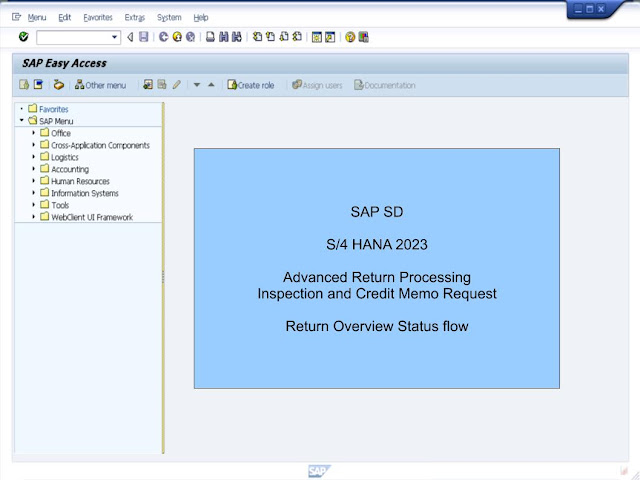This Blog is mainly on SAP Exam Questions and Selected "How-to" SAP processes
Saturday, December 30, 2023
Friday, December 29, 2023
Tuesday, December 26, 2023
Question no 3983 : Automatic Invoice scenarios
(more than one answers)
A. When Inspection Lot Usage Decision posted with Accepted Code.
B. When Goods Receipt screen is set with Automatic Invoice and Automatic PO indicators.
C. Goods Receipt of Purchase Order item with GR-Based IV and ERS indicator.
D. Pipeline settlement.
E. Consignment settlement.
Answer: C, D, E
C) Both GR-Based IV and ERS indicators are set in the Vendor (XK01 or XK02 in ECC) or BP Master (BP t-code in S/4). While the GR-Based IV will be defaulted to the Info Record and later to the PO item detail; the ERS indicator is not found in the Info Records and is directly defaulted from the Vendor/BP Master to the PO item detail. (note that there is however a "No ERS" indicator in the Info Record to switch of ERS requirement for Material-Vendor-Pur.Org-Plant combination).
There are 4 scenarios for Auto Invoice
- ERS Settlement for PO items with GR-Base IV and ERS indicator (MRRL). (Answer C)
- Pipeline Settlement (MRKO). (Answer D)
- Consignment Settlement (MRKO). (Answer D)
- Invoicing Plant Settlement (MRIS).
Saturday, December 23, 2023
Wednesday, December 20, 2023
Monday, December 18, 2023
Sunday, December 17, 2023
Saturday, December 16, 2023
Wednesday, December 13, 2023
Tuesday, December 12, 2023
Sunday, December 10, 2023
Saturday, December 9, 2023
Wednesday, December 6, 2023
Tuesday, December 5, 2023
Sunday, December 3, 2023
Friday, December 1, 2023
Wednesday, November 29, 2023
Monday, November 27, 2023
Q&A in Class (2023-12-01) S4200
---------------------------------------------------------------------------------------------------------------------------------------------------------------------------------------------
Storage Location ControlThe above 3 slides are extracts of setup in ECC6 EhP8.
BUT what about S/4 2022 where Storage Location data segment in Material Master MRP4 view is no longer available.
Check the following link to the Blog Post for the Possible Solution:SAP PP - Storage Location MRP (ECC EhP8 vs S/4 2022)
---------------------------------------------------------------------------------------------------------------------------------------------------------------------------------------------
Limited Production Order creation for a Material
Saturday, November 25, 2023
Thursday, November 23, 2023
SAP Acronyms (Part 11)
Login to a SAP system
comes Monday morning
Q&A in Class (2023-11-22) S4H00
---------------------------------------------------------------------------------------------------------------------------------------------------------------------------------------------
PS Internal Work Time Reporting- Create Sales Order with an order item (for example, standard order or repair order) that is account assigned to a WBS element in a customer project.
- The WBS element to be account assigned to the order item on the Account Assignment tab page.
- Enter a Dynamic Item Processor profile (DIP profile) in the tab strip Sales B for the order item.
- If you maintained the Dynamic Item Processor profile in a way so that the system takes the actual cost totals records as the source for the dynamic items.
- The system sorts the dynamic items according to the SD order items and determines the price of the billing request using SD Pricing . In this way the SD Billing will be based on the DIP Items Actual Costs.
---------------------------------------------------------------------------------------------------------------------------------------------------------------------------------------------
SAP Modules Abbreviations- PS - Project Structuring
- PS - Document integration (PS Text and integration to DMS or Document Management System)
- PS - Notification (Claims)
- PS - Time Scheduling and Capacity Evaluation
- PS - Cost Planning (including Easy Cost Planning)
- PS - Revenue Planning
- PS - Budgeting (including integration to FI-IM Financials - Investment Management)
- PS - Procurement of Materials and Services
- PS - Confirmation of Internal Project Activities
- PS - Billing (including Resource Related Billing)
- PS - Project Progress Analysis
- PS - Period End Closing and Settlement
- PS - Reporting (Structures, Logistics, and Accounting)




.jpg)
.jpg)
.jpg)
.jpg)
.jpg)
.jpg)



_0408_(09)ItemProposal_SODOBilling.jpg)
_0621_TrackSalesOrder.jpg)
_0413_(14)ConditionContract.jpg)
_0415_CustomerReturn.jpg)


_0517_PreliminaryBilling.jpg)





.jpg)








_Blogged.jpg)
_Blogged%20(1).jpg)
_Blogged%20(2).jpg)












